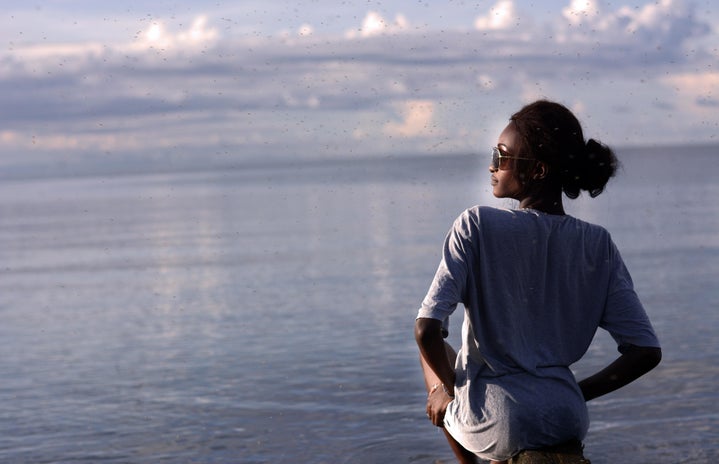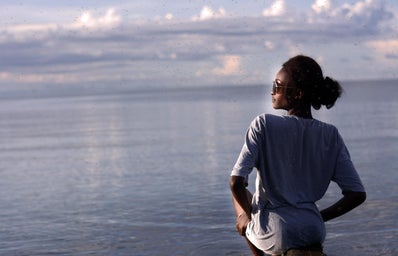Disclaimer: Those who have had issues with body dysmorphia or are currently experiencing issues with body dysmorphia should be advised as the following article may contain sensitive topics.
The first time I remember hating my body, I was ten. I wasn’t a chubby kid, but I was never one of those tall and lanky, skinny kids either. This never really bothered me until the summer between fifth and sixth grade. I went hiking up Whistler mountain that summer with my family and a friend. My parents had brought the camera, so my friend and I were having a blast playing photographer for the day and posing for silly photos on rocks and in front of trees. A few days later, mom came home with a stack of developed photos. I remember looking through all the pictures, trying to pick out the best ones to add to my photo album – but something kept bothering me.
When I recently came across a photo from that summer, I instantly broke into tears. How could someone so young bear so much insecurity? Yet, I still remember thinking about how you could see my slightly round tummy underneath the blue shirt I was wearing. Although this probably wasn’t the first time I had noticed that I had a bit of a tummy, it was when I started to care about how my body looked. What bothered me most was that I looked different standing there next to my skinny friend.
Over the next couple of years, I began to observe the other girls in my class. Did they have a rounder tummy like me? Or did they have a flat one like my friend from the photo? I didn’t know why my tummy was bad, or why I wasn’t supposed to like it, I just knew that I hated it. I hated the way I looked next to the other girls in school pictures, and how nervous I felt if my shirt came up over the top of my pants while reaching for something on the top shelf. It was then that I started to compare myself to my peers around me. I started out with whether I could make my stomach look as thin as the other girls by wearing certain clothes or sucking it in real hard before pictures, and ended with me comparing every square inch of my body to someone else’s and trying to wish away the parts I didn’t like.
In the seventh grade, I was introduced to the concept of the thigh gap. Up until this point, I hadn’t noticed that some girls had thinner legs than I did. According to Wikipedia, a thigh gap is the space that some people have between their inner thighs while standing upright with your feet together. I don’t know when this became a beauty standard pushed on women, but it did, and it was brought to my attention at age 12. Supposedly, this is an impossible beauty standard to achieve, as most bodies are not built for the possibility of a thigh gap, but seventh grade me didn’t care. I did not have a thigh gap, and my thighs touching became another form of measurement which assured me that my body was too big.
In the eighth grade, I was introduced to the concept of thin arms. Much like seventh grade me, eighth grade me had not realized that some girls had arms that were more round that others. I was one of those girls. I began to hate how my arms looked in tank tops, and how they didn’t look as small or dainty as the other girls in my ballet class. From here, I was introduced to prominent collar bones and hip bones. Apparently, these were also a sign of having the perfect body. Apparently, being thin enough that you could see the definition of certain bones under your skin is beautiful. I thought so, or at least I was told that I was supposed to think that. I’ve always had prominent collar bones, despite never being thin, and to this day when I feel uncomfortable in my own skin, running my hands over my collar bones has been a form of comfort. Despite having the collar bones, I was still missing the flat stomach, the hip bones, the thigh gap and the dainty arms, and having only 20% of a “perfect” body was never going to be enough for me.
It didn’t help that in eighth grade I was one of the few girls who had hit puberty early, so unlike most I was the exact opposite of flat chested. This became yet another way that my body differed from everyone around me, and I continued to hate it. I hated that I couldn’t wear those cute Aritzia bustier tops that every girl had because a size Large still didn’t fit my bust. We’ve all been told that clothing size doesn’t matter, that it’s inconsistent and that it’s how you look and feel, but being 13 and uncomfortable in my own skin was bad enough. Finding out that I was too big for the biggest size cut that much deeper. I wanted to be size 2 with a tiny waist, and no amount of people telling me my body was fine the way it is was going to change my mind. So I went out and bought one of those tops that every girl had, and hoped it would make me feel like I fit in. The low-cut neckline brought too much attention to my chest, and I didn’t like the way the fabric hugged my stomach. I felt even bigger than I had before, and slowly I began to slouch in hopes that it would make me look smaller.
Despite all these things, I tried to love myself. I told myself that my legs were big and strong from the years of dance, soccer and skiing I had done. That my arms and stomach still held on to some baby fat and that once I grew into my body, those hip bones would become prominent. I hoped that my busty chest would ‘pay off’ when I grew up and tried to tell myself that I was ‘lucky’, like every other eighth grade girl told me. I tried to ignore the fact that I felt uncomfortable in a bikini or a tank top and the pit in my stomach I got while changing in the girls’ locker room. I couldn’t shake the constant feeling that everyone was staring at me all the time, and silently picking apart my body in their heads. If I was doing it, why wouldn’t they be doing it, too? I tried to push through those feelings and love myself, just like I was told. So, I continued to laugh when my friends jokingly called me thunder thighs in gym class and tried not to feel like a stranger in my own skin. I made sure my gym clothes were big and baggy in hopes of hiding the way my legs and stomach jiggled when we ran laps, but as much as I tried, I couldn’t help but wake up every morning and wish that I could cut the ugly bits of my body away.
By ninth grade, I was tired of pinching the fat around my hips and wishing it would disappear. I decided I had to take matters into my own hands instead of wishing I had the perfect body; I was going to make my body the perfect body.
What could possibly go wrong with that?



